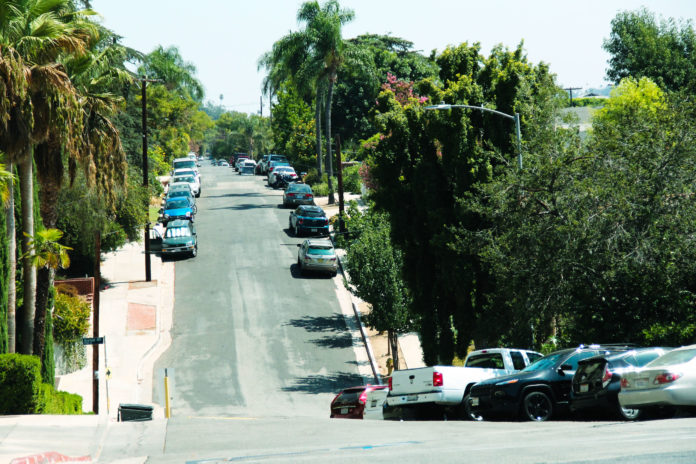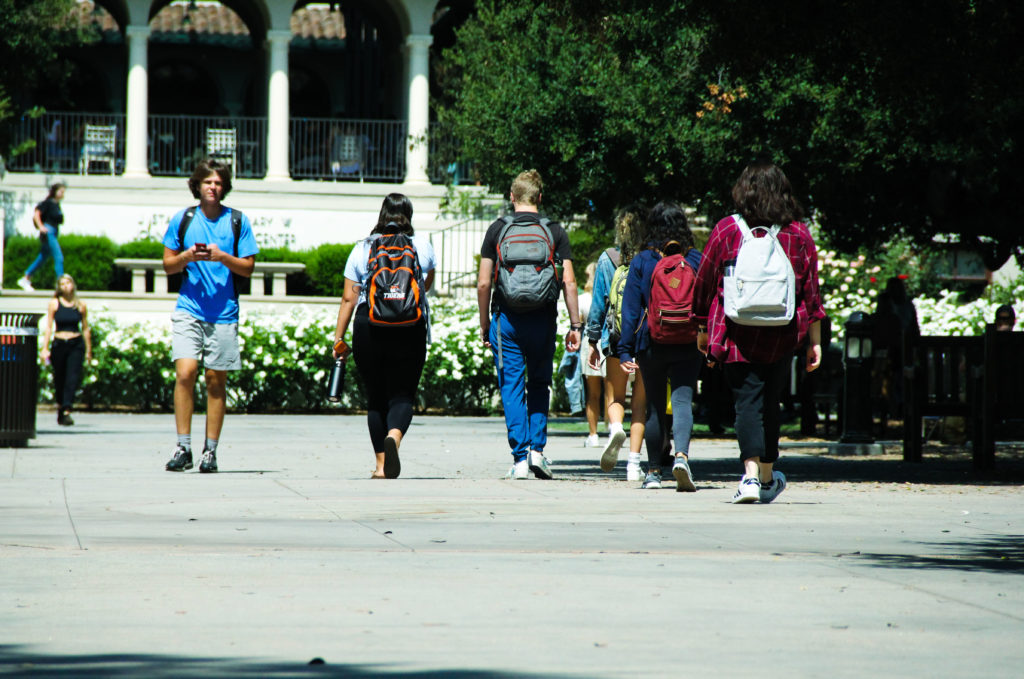
Ina Morton (sophomore) claims that last year, she had the most beautiful commute in the world. During her first year at Occidental, on the way home from her internship in Downtown LA, she always traveled back to school on the Metro’s Gold Line just before the sun was starting to set. She loved spending her 15-minute journey looking out the window, watching Downtown LA on one side and the hills on the other.
“It’s a different experience when you’re on the bus rather than on the freeway,” Morton said. “On the freeway, you’re just surrounded by sound walls going downtown, but when you’re on the bus, you’re looking out the windows, block by block, and seeing the people who live here.”
LA is an infamously sprawling city. Occidental students who take on the challenge of traveling to different areas for work, exercise or fun end up spending much of their time in transit. Time spent ‘getting somewhere’ becomes a vital part of students’ experience living in LA, an experience defined by the qualities and capabilities of their transportation, what they see along the way and the people they share it with.
Morton has used the LA Metro her whole life, and it was a sign of independence when she was first allowed to take the bus and subway by herself. The metro opened up the city to her and kickstarted her love affair with LA.
“The metro was very much a gateway drug into me really loving cities and urbanism,” Morton said. “The single thing that has made me love this city the most, and makes me feel like I understand it the most, is when I take Metro.”
During her time at Occidental, she has fallen into a sort of ambassadorial role for Metro, lauding its beauty to other students and trying to convince them to give public transportation a chance. She wants to share the way she sees and loves LA with others.
Morton remembers her first week of school at Occidental, when she confided to her newly formed friend group that she was from LA and knew how to use the public transportation system. That first weekend, she guided them all the way to Santa Monica by metro, transferring twice in an attempt to catch a midnight movie. She worried that her friends might be having a terrible time and might be regretting being on the bus, or that they specifically might be regretting being with her on the bus, wondering ‘Who is this crazy Angeleno?’ But they enjoyed the ride together and made their movie on time. Most importantly, their friendship endured the extensive ride home.
According to Morton, LA is afflicted with what she calls “car culture,” and the idea that ‘Everyone drives in LA.’ She believes these stereotypes keep more people from using Metro while alienating the people who do. To her, this is particularly problematic because the majority of people who rely on public transportation are low-income people and people of color.
“There’s very much a presumption in the city that you drive, and if you don’t drive, it’s like you don’t even exist,” Morton said. “When you say ‘Nobody does these things,’ what about the hundreds of thousands of people who do that every day? Why are they not real Angelenos?”

Last year, Morton spent about $30 a month traveling by metro. She was extremely excited when this year she heard that she could ride the metro for free through Occidental’s new Metro U-Pass program, instituted Aug. 27. The program, organized by the Associated Students of Occidental College (ASOC), gives students free Metro cards and pays their fare. As a true believer in public transportation, Morton was equally excited to see so many students out and in line to get their free Metro passes. she joked that the line for the Metro cards was the longest line of students that she had seen at Occidental since convocation.
“That’s just how powerful free transit is,” Morton said.
Jordan Walker (junior), the vice president of financial affairs for ASOC, came up with the idea for the U-Pass program. At first, Walker ordered 200 cards to give out because he was unsure what the student response would be, but eventually had to order many more. As of Sept. 30, 680 students have claimed their TAP cards through the program.
“It is a really good thing,” Walker said. “It helps us all, whether it’s about improving the environment or generally investing in infrastructure that folks need. And I think that it is really important to make it become more normal for people to decide not to just get in a car to go somewhere.”
Seva Rodnyansky, assistant professor in the Urban & Environmental Policy department, has dedicated his research to studying public transportation and how that infrastructure affects where people choose to live.
According to Rodnyansky, Eagle Rock’s lack of commerciality, high levels of traffic and distance from Downtown LA are why the neighborhood and Occidental College are less thoroughly connected to public transportation than other LA colleges. This makes the metro more difficult and less efficient for students to use.
The proposed North Hollywood to Pasadena Bus Rapid Transit (BRT) has the opportunity to change the quality of public transportation for students and Eagle Rock residents. Rodnyansky said the BRT will likely cause increased traffic and decreased lanes and parking, which has spurred controversy in the area, but could also greatly improve the accessibility to and from Eagle Rock.
“Things are evolving,” Rodnyansky said. “And there has been significant movement towards more active transportation, like biking and walking, as well as towards public transit.”

After a year of figuring out how to get around using her bike and the metro, Antigone Lambros (sophomore) learned that the two are better together. On long journeys, she likes to bike one way and rest on the metro while heading back to campus.
Back home in Missoula, MT, Lambros biked everywhere. But when she moved to Occidental last fall, she said that starting to bike in LA seemed impossible. She needed some help from Occidental’s Bike Share Program, and she got it.
When most students think of Bike Share, they think of the bikes the program loans to students and the bike repairs workers do in the quad every Friday. According to Phillip Wong (senior), Bike Share co-manager, the program also focuses on teaching students how and where to bike safely and creating a community where students can enjoy biking together.
“I think that it takes a little bit of time to get comfortable with being uncomfortable with being on a bike,” Wong said.
Lambros’ first bike downtown was with one of Bike Share’s group ride events. After they showed her the safest and most scenic way to make the 16-mile round trip, she realized that biking in LA was a lot easier and more enjoyable than she had expected it to be.
“It didn’t feel like I was in the middle of a city trying to get downtown. It was a really beautiful bike near the LA River,” Lambros said. “And then all of a sudden I was downtown.”
Now, Lambros said she feels capable of exploring by herself and is proud that she knows her way around Eagle Rock. She loves to bike through the small neighborhoods near Occidental — the more colorful houses there are, the better. When a house is particularly interesting to her, or when a color or a pattern catches her eye, she stops her bike and takes a picture. There is an entire folder on her phone dedicated to these images. She likes to make art, and these images serve as inspiration for her drawings.
Despite her love of biking and using the Metro, Lambros sometimes wishes she had a car. She uses Uber sometimes, but it is expensive. Biking is useful for seeing parts of LA, but she says that she cannot imagine anyone being able to see all of LA that way.
For students looking for a cost-effective ride, the Bengal Bus is a free service on campus that drives students within a 7-mile radius during specific hours each week.
August Barringer (senior) is a Bengal Bus driver who helps students with everything from their CVS and takeout runs to excursions to Griffith Park, the Goodwill bins and Dodger Stadium.
“I don’t think you necessarily need a car to fully take advantage of everything LA has to offer, but it’s convenient,” Barringer said.

Between her Bengal Bus shifts and personal driving time, Barringer spends approximately 10 hours a week in a car. But she doesn’t mind; she has always loved to drive.
“LA is so big,” Barringer said. “The thing that gets me is that you can drive for so long in one direction and still be in LA.”
Sometimes she likes to drive just for the sake of exploring. One night when Barringer was driving around the small roads surrounding Occidental, not going anywhere specifically, she found an amazing view that is now one of her favorite places near campus.
“The mountains within LA, they’re fairly steep, and so there are all of these roads that kind of wind up within them, and this one mountain has a road that goes right along the crest,” Barringer said. “For a while there are houses on either side of the road, and you can peek through the houses and see the view. But when you get to this one point, all of a sudden there aren’t any houses anymore, and there is just a white wooden fence on either side that is only three feet high or so. And on both sides, the hill just drops off. On one side you see Downtown LA and on the other side, you see the mountains that are north of LA, and it’s just like, ‘Oh, wow.'”
This favorite place of Barringer’s is the 360-degree view from the top of Mt. Washington, where it is absolutely clear how large the the city is. Looking toward downtown, Barringer called the movement of the highway lights mesmerizing, and compared it to the Foucault pendulum in the Hameetman Science Center. On the other side, there is a view of the San Gabriel Mountains and the smaller roads and sparser houses beneath them. Even though they do not glow brightly like the lights from the other side of the city, Barringer called the mountains beautiful.
Between one end of LA and the other, there is a massive amount of space, and there are many cars — and buses, trains and bikes too — connecting all of the different neighborhoods together. After watching in silence for a few minutes, Barringer pointed her finger out of the driver’s side window toward a dimly lit neighborhood between her and the mountains.
“Look,” Barringer said. “Over there is Oxy.”
![]()



































